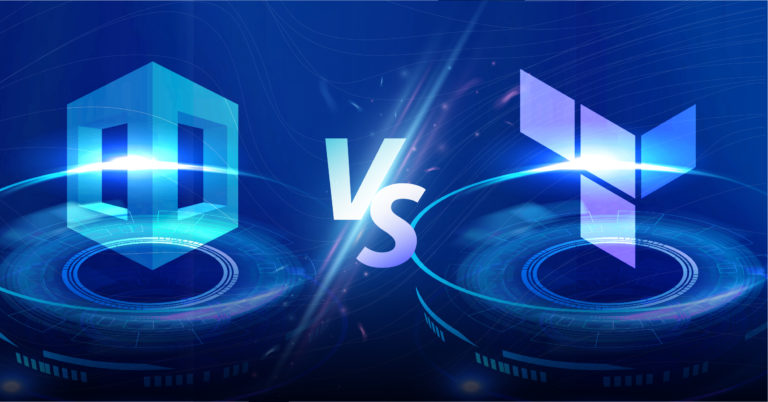
Terraform vs. Cloudformation

Principal DevOps Engineer
This blog was originally published on InfoQ.
While both CloudFormation and Terraform are robust IaC platforms that offer efficient configuration and automation of infrastructure provisioning, there are a few key differences in the way they operate. CloudFormation is an AWS tool, making it ideal for AWS users looking for a managed service. Terraform, on the other hand, is an open-source tool created by Hashicorp which provides the full flexibility, adaptability, and community that the open-source ecosystem has to offer. These differences can be impactful depending on your specific environment, use cases, and several other key factors.
In this post, I’ll compare CloudFormation and Terraform based on important criteria such as vendor neutrality, modularity, state management, pricing, configuration workflow, and use cases to help you decipher which one is the best fit for you.
But first, I’ll provide a bit of background on each platform and highlight the unique benefits that each of them brings to the table.
What is CloudFormation?
AWS CloudFormation is an Infrastructure as Code (IaC) service that enables AWS cloud teams to model and set up related AWS and third-party resources in a testable and reproducible format.
The platform helps cloud teams focus on the application by abstracting away the complexities of provisioning and configuring resources. You also have access to templates to declare resources; CloudFormation then uses these templates to organize and automate the configuration of resources as well as AWS applications. It supports various services of the AWS ecosystem, making it efficient for both startups and enterprises looking to persistently scale up their infrastructure.
Key features of CloudFormation include:
- Declarative Configuration with JSON/YAML
- The ability to preview environment changes
- Stack management actions for dependency management
- Cross-regional account management
What is Terraform?
Terraform is Hashicorp’s open-source infrastructure-as-code solution. It manages computing infrastructure lifecycles using declarative, human-readable configuration files, enabling DevOps teams to version, share, and reuse resource configurations. This allows teams to conveniently commit the configuration files to version-control tools for safe and efficient collaboration across departments.
Terraform leverages plugins, also called providers, to connect with other cloud providers, external APIs, or SaaS providers. Providers help standardize, provision, and manage the infrastructure deployment workflow by defining individual units of infrastructure as resources.
Key features of Terraform include:
- Declarative configurations via Hashicorp Configuration Language (HCL)
- The support of local and remote execution modes
- Default version control integration
- Private Registry
- Ability to ship with a full API
Comparing Terraform and CloudFormation
Vendor Neutrality
The most well-known difference between CloudFormation and Terraform is the association with AWS. While you can access both tools for free, as an AWS product, CloudFormation is only built to support AWS services. Consequently, it is only applicable for deployments that rely on the AWS ecosystem of services. This is great for users who run exclusively on AWS as they can leverage CloudFormation as a managed service for free and at the same time, get support for new AWS services once they’re released.
In contrast, Terraform is open-source and works coherently with almost all cloud service providers like Azure, AWS, and Google Cloud Platform. As a result, organizations using Terraform can provision, deploy, and manage resources on any cloud or on-premises infrastructure, making it an ideal choice for multi-cloud or hybrid-cloud users. Furthermore, because it is open source and modular, you can create a provider to wrap any kind of API or just use an existing provider. All of these capabilities have already been implemented by various vendors which offer users far more flexibility and convenience, making it ideal for a greater variety of use cases.
However, on the downside, Terraform often lags behind CloudFormation with regard to support for new cloud releases. As a result, Terraform users have to play catch-up when they adopt new cloud services.
Modularity
Modules are purposed for reusing and sharing common configurations, which renders complex configurations simple and readable. Both CloudFormation and Terraform have module offerings, however, CloudFormation’s is newer, and therefore not as mature as Terraform’s.
CloudFormation has always offered features to build modules using templates, and as of 2020, they now offer out-of-the-box support for modules as well. Traditionally, CloudFormation leverages nested stacks, which allow users to import and export commonly used configuration settings. Over the past few years, however, CloudFormation launched both public and private registries. As opposed to Terraform, CloudFormation offers its private registry right out-of-the-box which enables users to manage their own code privately without the risk of others gaining access to it. Furthermore, CloudFormation’s public registry offers a wide array of extensions such as MongoDB, DataDog, JFrog, Check Point, Snyk, and more.
Despite the fact that CloudFormation has come a long way in its modularity, Terraform has innately supported modularity from the get-go, making its registry more robust and easier to use. The Terraform registry contains numerous open-source modules that can be repurposed and combined to build configurations, saving time and reducing the risk of error. Terraform additionally offers native support for many third-party modules, which can be consumed by adding providers or plugins that support the resource type to the configuration.
State Management
One of the benefits of CloudFormation is that it can provision resources automatically and consistently perform drift detection on them. It bundles AWS resources and their dependencies in resource stacks, which it then uses to offer free, built-in support for state management.
In contrast, Terraform stores state locally on the disk by default. Remote storage is also an option, but states stored remotely are written in a custom JSON file format outlining the model infrastructure and must be managed and configured. If you do not manage state storage properly, it can have disastrous repercussions.
Such repercussions include the inability to perform DR because drifts have gone undetected, leading to extended downtime. This occurs if the state is impaired and can’t run the code, which means the recovery has to be done manually or started from scratch. Another negative repercussion is if the state file for some unexpected reason becomes public. Since state files often store secrets such as keys to databases or login details this information is quite dangerous to your organization if it gets into the wrong hands. If Hackers find state files it’s easier for them to attack your resources. This is an easy mistake to make since generally speaking, Terraform users that manage their own state on AWS store the files in an S3 bucket, which is one-way state files can be exposed publicly.
To combat this challenge, Terraform also offers an efficient deployment of self-managed systems that take care of the state by leveraging AWS S3 and DynamoDB. In addition, users can also purchase Terraform’s Remote State Management to automatically maintain state files as a service.
Pricing, License, & Support
CloudFormation is a free service within AWS and is supported by all AWS pricing plans. The only cost associated with CloudFormation is that of the provisioned AWS service.
Terraform is open-source and free, but they also offer a paid service called Terraform Cloud which has several support plans like Team, Governance, and Business that enable further collaboration. Terraform Cloud offers additional features like team management, policy enforcement, a self-hosted option, and custom concurrency. Pricing depends on the features used and the number of users.
Language
CloudFormation templates are built using JSON/YAML, while Terraform configuration files are built using HCL syntax. Although both are human-readable, YAML is widely used in modern automation and configuration platforms, thereby making CloudFormation much easier to adopt.
On the other hand, HCL enables flexibility in configuration, but the language requires getting used to it.
It’s also worth mentioning some IaC alternatives that offer solutions for those who prefer to use popular programming languages. For example, in addition to CloudFormation, AWS offers CDK which enables users to provision resources using their preferred programming languages. Terraform users can enjoy the same benefits with AWS cdktf which allows you to set HCL state files in Python, Typescript, Java, C#, and Go. Alternatively, Pulumi offers an open-source IaC platform that can be configured with a variety of familiar programming languages.
Configuration Workflow
With CloudFormation, the written code is stored by default locally or in an AWS S3 bucket. This configuration workflow is then used with the AWS CLI or the AWS Console to build the resource stack.
Terraform uses a straightforward workflow that only relies on the Terraform CLI tool to deploy resources. Once configuration files are written, Terraform loads these files as modules, creates an execution plan, and applies the changes once the plan is approved.
Use Cases
While both CloudFormation and Terraform can be used for most standard use cases, there are some situations in which one might be more ideal than the other.
Being a robust, closed-source platform that is built to work seamlessly with other AWS services, CloudFormation is considered most suitable in a situation where organizations prefer to run deployments entirely on AWS and achieve full state management from the get-go.
CloudFormation makes it easy to provision AWS infrastructure. Plus, you can more easily take advantage of new AWS services as soon as, or shortly after, they’re launched due to the native support, compliance, and integration between all AWS services. In addition, if you’re working with developers, the YAML language tends to be more familiar, making CloudFormation much easier to use.
In contrast, Terraform is best suited for dynamic workloads residing in multiple deployment environments where you want to control additional systems beyond the cloud. Terraform offers providers specifically for this purpose whereas CloudFormation requires you to wrap them with your own code. Hybrid cloud environments are also better suited for Terraform. This is because it can be used with any cloud (not exclusively AWS) and can, therefore, integrate seamlessly with an array of cloud services from various providers–whereas this is almost impossible to do with CloudFormation.
Furthermore, because it’s open source, Terraform is more agile and extendable, enabling you to create your own resources and providers for various technologies you work with or create.
Your given use case may also benefit from implementing both–for example, with multi-cloud deployments that include AWS paired with other public/private cloud services.
Another example where both may be used in tandem is with serverless architecture. For example at Zesty, we use Serverless which uses CloudFormation under the hood. However, we also use Terraform for infrastructure. Since we work with companies using different clouds, we want to have the ability to use the same technology to deploy infrastructure in multiple cloud providers, which makes Terraform the obvious choice for us. Another unplanned benefit this adds for us is the natural segregation between Dev and Ops. Because Ops tend to be more familiar with the HCL language, it creates barriers that make it more difficult for another team to make a mistake or leave code open to attacks.
In general, many organizations choose to use Terraform for databases and high-level infrastructure and CloudFormation for application deployment. They often do this because it helps to distinguish the work of Dev and Ops. It’s easier for developers to start from scratch with CloudFormation because it runs with YAML or JSON which are formats every developer knows. Terraform, on the other hand, requires you to learn a different syntax. The benefit of creating these boundaries between Dev and Ops is that one team cannot interfere with another team’s work, which makes it harder for human error or attacks to occur.
It’s worth noting that even if you don’t currently use both IaC platforms, it’s ideal to learn the syntax of each in case you wind up using one or the other in the future and need to know how to debug them.
Summary
As we have seen, both CloudFormation and Terraform offer powerful IaC capabilities, but it is important to consider your workload, team composition, and infrastructure needs when selecting your IaC platform.
Because I’m partial to open-source technologies, Terraform is my IaC of choice. It bears the Hashicorp name, which has a great reputation in the industry as well as a large and thriving community that supports it. I love knowing that if I’m not happy with the way something works in Terraform, I can always write code to fix it and then contribute it back to the community. In contrast, because CloudFormation is a closed system, I can’t even see the code, much less change something within it.
Another huge plus for Terraform is that it uses the HCL language which I prefer to work with over JSON/YAML. The reason for this is that HCL is an actual language whereas JSON and YAML are formats. This means when I want to run things programmatically, like running in a loop or adding conditionals, for example, I end up with far more readable and writable code. When code is easier to read, it’s easier to maintain. And since I’m not the only one maintaining this code, it makes everyone’s life easier.
Another reason I prefer to use Terraform is due to our extensive use of public modules, which we needed to leverage prior to CloudFormation’s public registry offering.
While CloudFormation may be quicker to adopt new AWS features and manage the state for you for free, all things considered, I prefer the freedom that comes with open source, making Terraform a better choice for my use case.
Hope you found this comparison helpful!
Related Articles
-
How we cut Kubernetes costs by half at Wildflower
September 30, 2025 -
 Why it’s time to get off the manual Kubernetes optimization treadmill
Why it’s time to get off the manual Kubernetes optimization treadmill
August 14, 2025 -
 The endless cycle of manual K8s cost optimization is costing you
The endless cycle of manual K8s cost optimization is costing you
July 2, 2025 -
 This is the #1 cloud budget killer (and it’s easier to fix than you think)
This is the #1 cloud budget killer (and it’s easier to fix than you think)
June 16, 2025 -
 K8s users were waiting years for this, and v1.33 just made it real
K8s users were waiting years for this, and v1.33 just made it real
June 12, 2025



